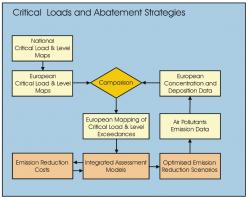
Critical Loads (CL)
 |
Critical Load Project in the
|
The Convention on Long-range Transboundary Air Pollution (Convention on LRTAP) was the first international legally binding instrument to deal with problems of air pollution on a broad regional basis. Signed in November 1979 it entered into force in March 1983. The Convention, which now has 51 Parties, has been extended by eight protocols. The United States ratified the Convention in 1981 and four of the protocols (Status of the Convention and its related Protocols).
 An important part of the effects related work under the Convention has been the mapping of Critical Loads and Levels. Under the idea of Critical Loads & Levels, we understand scientifically based values of pollutants concentration or deposition. Remaining at, or staying under these levels guarantees, based on today’s knowledge, that a selected area / object (called the ecological receptor) will be neither damaged acutely nor in the long-term. The ecological receptors can be entire ecosystems, parts of those systems, or single organisms. Also included as ecological receptors are objects such as buildings, materials, or objects of historical significance that one wishes to protect from pollution
An important part of the effects related work under the Convention has been the mapping of Critical Loads and Levels. Under the idea of Critical Loads & Levels, we understand scientifically based values of pollutants concentration or deposition. Remaining at, or staying under these levels guarantees, based on today’s knowledge, that a selected area / object (called the ecological receptor) will be neither damaged acutely nor in the long-term. The ecological receptors can be entire ecosystems, parts of those systems, or single organisms. Also included as ecological receptors are objects such as buildings, materials, or objects of historical significance that one wishes to protect from pollution
Critical Levels: concentrations of pollutants in the atmosphere above which direct adverse effects on receptors, such as human beings, plants, ecosystems or materials, may occur according to present knowledge.
Critical Loads: a quantitative estimate of an exposure to one or more pollutants below which significant harmful effects on specified sensitive elements of the environment do not occur according to present knowledge.
The Critical Load project group at ECO-DATA compiles data and maps depicting the burdens (pollution) and the burdenability (load capacity) of ecological systems. The project focus reflects work within different scales. Critical and actual loads can be compared at the state and local levels. The comparisons could, for example, yield strategies for setting pollution emission-limits. The comparisons could also be used to implement policies that balance out and compensate for air pollutants.


